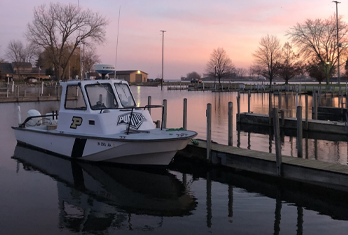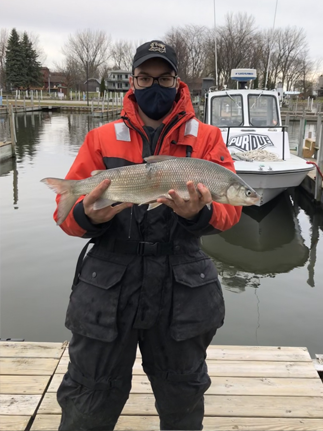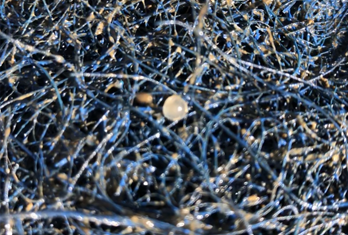A research team including Tomas Höök, director of Illinois-Indiana Sea Grant and professor of fisheries and aquatic sciences at Purdue, will be providing a checkup on the Coreyon Reef Project in Saginaw Bay in Lake Huron through a new grant from the Michigan Department of Natural Resources and the Environmental Protection Agency.
aquatic sciences at Purdue, will be providing a checkup on the Coreyon Reef Project in Saginaw Bay in Lake Huron through a new grant from the Michigan Department of Natural Resources and the Environmental Protection Agency.
 aquatic sciences at Purdue, will be providing a checkup on the Coreyon Reef Project in Saginaw Bay in Lake Huron through a new grant from the Michigan Department of Natural Resources and the Environmental Protection Agency.
aquatic sciences at Purdue, will be providing a checkup on the Coreyon Reef Project in Saginaw Bay in Lake Huron through a new grant from the Michigan Department of Natural Resources and the Environmental Protection Agency.Höök has been involved with the Coreyon Reef Project since 2014.
The installation of a reef in the inner Saginaw Bay, located 8.5 miles west of Fish Point, Michigan, or 10 miles north of Quanicassee, in the fall of 2019 was the culmination of a multi-year effort to overcome environmental degradation in Saginaw Bay caused by over a century of sediment runoff in the water from industries such as logging and agriculture. The goal of  the project is to restore native fish populations to the Great Lakes, by creating additional spawning habitat for native species as well as helping diversify local fish populations.
the project is to restore native fish populations to the Great Lakes, by creating additional spawning habitat for native species as well as helping diversify local fish populations.
 the project is to restore native fish populations to the Great Lakes, by creating additional spawning habitat for native species as well as helping diversify local fish populations.
the project is to restore native fish populations to the Great Lakes, by creating additional spawning habitat for native species as well as helping diversify local fish populations.“This project has been developing for several years,” Höök said. "The restoration of Coreyon reef builds directly from a pre-restoration assessment we conducted in 2014-2016. I’m very excited to see how fish are now using this restored habitat. We hope to learn a lot from this project to inform how reef habitats may be restored and assessed in Saginaw Bay and elsewhere in the Great Lakes in the future.”
After a multi-year assessment of potential reef sites, the Coreyon Reef location was selected and the reef was built with glacial till, mimicking the historically formed rock reefs which were the result of glacial  deposits in the Great Lakes. The Coreyon Reef Project created small rock formations by taking rocks from the shore, ranging from four to eight inches in diameter, and piling the nearly 27,000 tons of rocks to create a three-acre reef, rising two to four feet from the lake bottom. Rocks were strategically placed, leaving room between the rocks for fish to lay their eggs.
deposits in the Great Lakes. The Coreyon Reef Project created small rock formations by taking rocks from the shore, ranging from four to eight inches in diameter, and piling the nearly 27,000 tons of rocks to create a three-acre reef, rising two to four feet from the lake bottom. Rocks were strategically placed, leaving room between the rocks for fish to lay their eggs.
 deposits in the Great Lakes. The Coreyon Reef Project created small rock formations by taking rocks from the shore, ranging from four to eight inches in diameter, and piling the nearly 27,000 tons of rocks to create a three-acre reef, rising two to four feet from the lake bottom. Rocks were strategically placed, leaving room between the rocks for fish to lay their eggs.
deposits in the Great Lakes. The Coreyon Reef Project created small rock formations by taking rocks from the shore, ranging from four to eight inches in diameter, and piling the nearly 27,000 tons of rocks to create a three-acre reef, rising two to four feet from the lake bottom. Rocks were strategically placed, leaving room between the rocks for fish to lay their eggs.The area is a spawning ground for walleye, smallmouth bass and suckers in the spring and lake whitefish, cisco, lake trout and burbot in the fall.
Initial post construction evaluation of the reef was conducted by the Michigan Department of Natural Resources days after the reef was completed. The area was mapped with sonar and crews looked for fish colonizing the reef.
A more thorough biological assessment of the reef was delayed somewhat due to travel and field work restrictions related to COVID-19. However, the biological assessment has now begun. The on-the-water assessment is being led by Scott Koenigbauer, a PhD student in Purdue’s Department of Forestry and Natural Resources, with oversight provide by Höök and David Fielder, a fisheries biologist with the Michigan Department of Natural Resources.
The team will set nets to evaluate if fish in spawning condition are occupying the reef, with a focus on lake whitefish and walleye. They will put out egg mats to assess the density of eggs deposited on the reef. In addition, they will capture various fish and  examine their diets to see if predation of eggs is an issue, and they will use dissolved oxygen sensors to determine if low oxygen conditions may be a concern for incubating eggs.
examine their diets to see if predation of eggs is an issue, and they will use dissolved oxygen sensors to determine if low oxygen conditions may be a concern for incubating eggs.
 examine their diets to see if predation of eggs is an issue, and they will use dissolved oxygen sensors to determine if low oxygen conditions may be a concern for incubating eggs.
examine their diets to see if predation of eggs is an issue, and they will use dissolved oxygen sensors to determine if low oxygen conditions may be a concern for incubating eggs.Initial funding for the Coreyon Reef Project was provided through $980,000 Environmental Protection Agency, Great Lakes Restoration Initiative (GLRI) grant and a $25,000 Saginaw Bay Watershed Initiative Network grant.





